How to Send an Email Campaign
In this article, we'll look at how to create and send a personalized campaign to your mailing list using the campaign wizard.
Read also: How to Create and Send an A/B test.
In the "Email" section, click Create campaign.
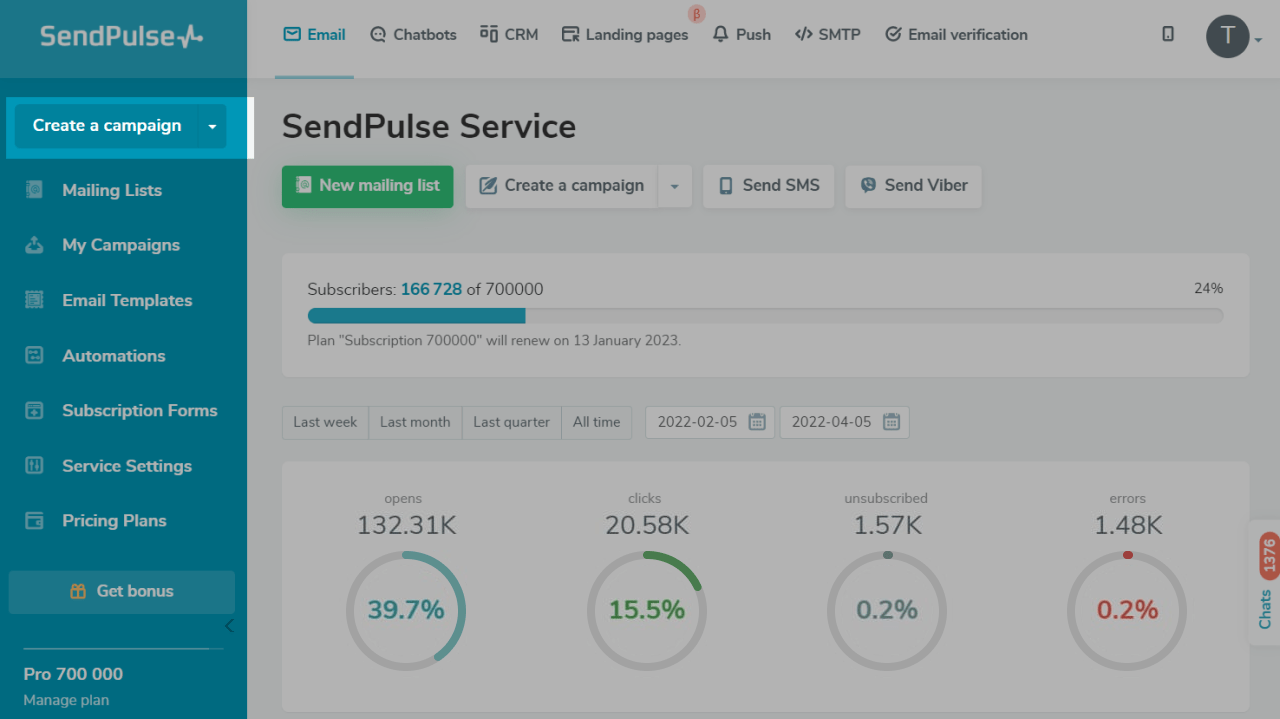
Step 1: Add Information about the Campaign
Specify Recipients
You can send a campaign to your mailing list contacts or course students.
The platform uses variables for email personalization from the selected contact info source. If you specify a mailing list, you can add variable names from it to your email template and subject line.
You cannot use mailing list variables when sending a campaign to course students.
Sending to Your Mailing List Contacts
Select one or several mailing lists you want to send the campaign to.
Read also: How to Create a Mailing List with Variables.
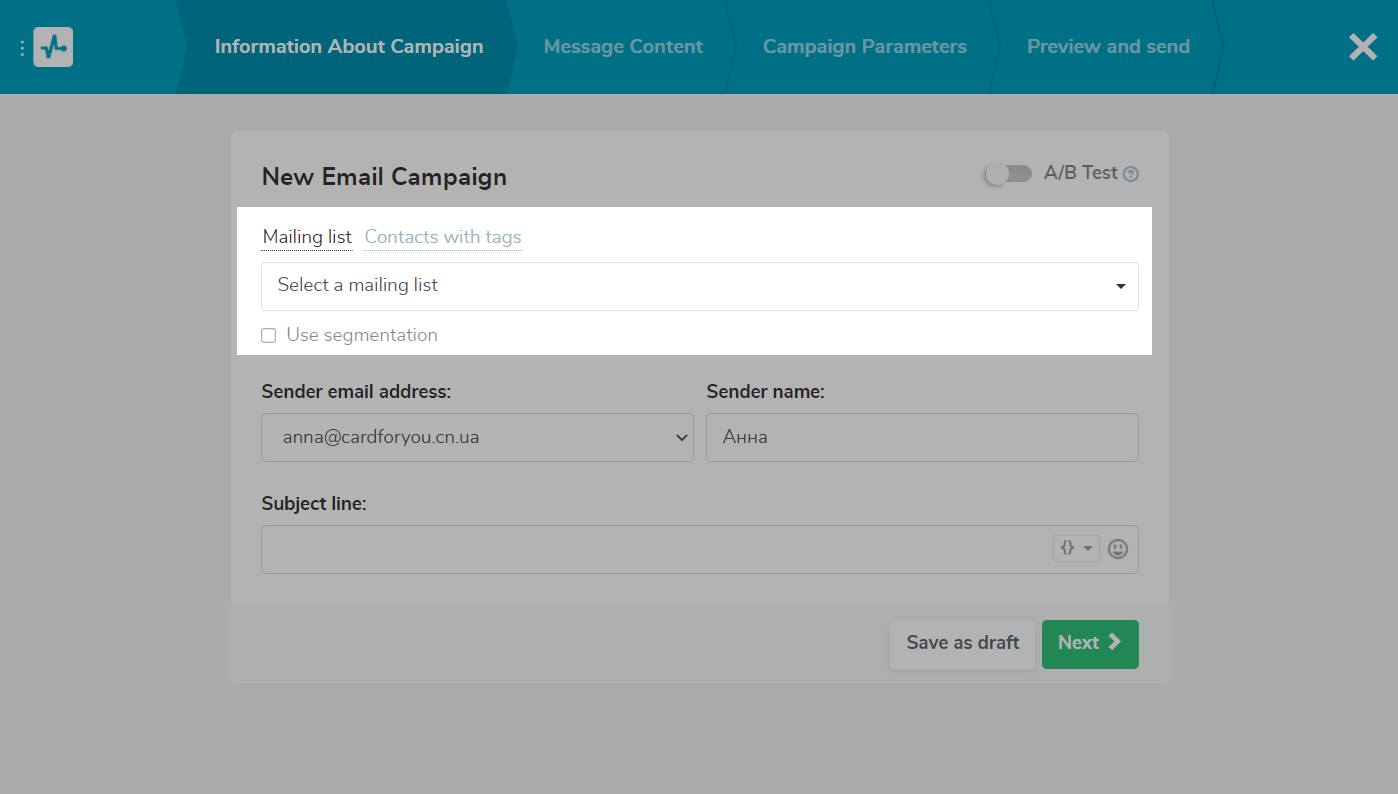
For a more personalized customer experience, you can segment your audience based on the recipients' data. Check "Segment List," and select the segmentation conditions.
Read also: How to Сreate and Use Mailing List Segments and How to Send an Email Campaign Using Segmentation.

You can also segment the campaign and send it to subscribers with a specific tag.
Read more: How to Create a Campaign for Subscribers with a Specific Tag.
Sending to Your Course Students
You can send a campaign to your course students’ email addresses. Go to the “Course students” tab, and select a course name from the drop-down list.

Then, select a group of students based on their payment status and course progress:
- All students
- Registered
- Paid
- Unpaid
- Taking a course
- Successfully completed course
- Failed course
- Got certificate
- Deleted from the course
- The student is invited to the course
You can also segment your students using tags.

Enter the Sender
Select the sender’s address and name.
Read more: How to Add a New Email Sender Address.

Specify the Email Subject Line
Enter the email subject line.
Think of your email subject line as the call to the action part of the email, since it serves as an incentive for recipients to open and read the campaign.
Read also: 11 Subject Line Hacks to Level Up Your Inbox Game.
You can personalize the email and add emojis and customer data. To do this, click on {}, and select a variable from which you want to transfer values.
Note: To use data from variables in emails, variable names must match in mailing lists and templates completely. If you capitalize the variable name in the mailing lists, for example, {{Name}}, capitalize the variable name in the templates as well.
Read also: How to Create Custom Variables.
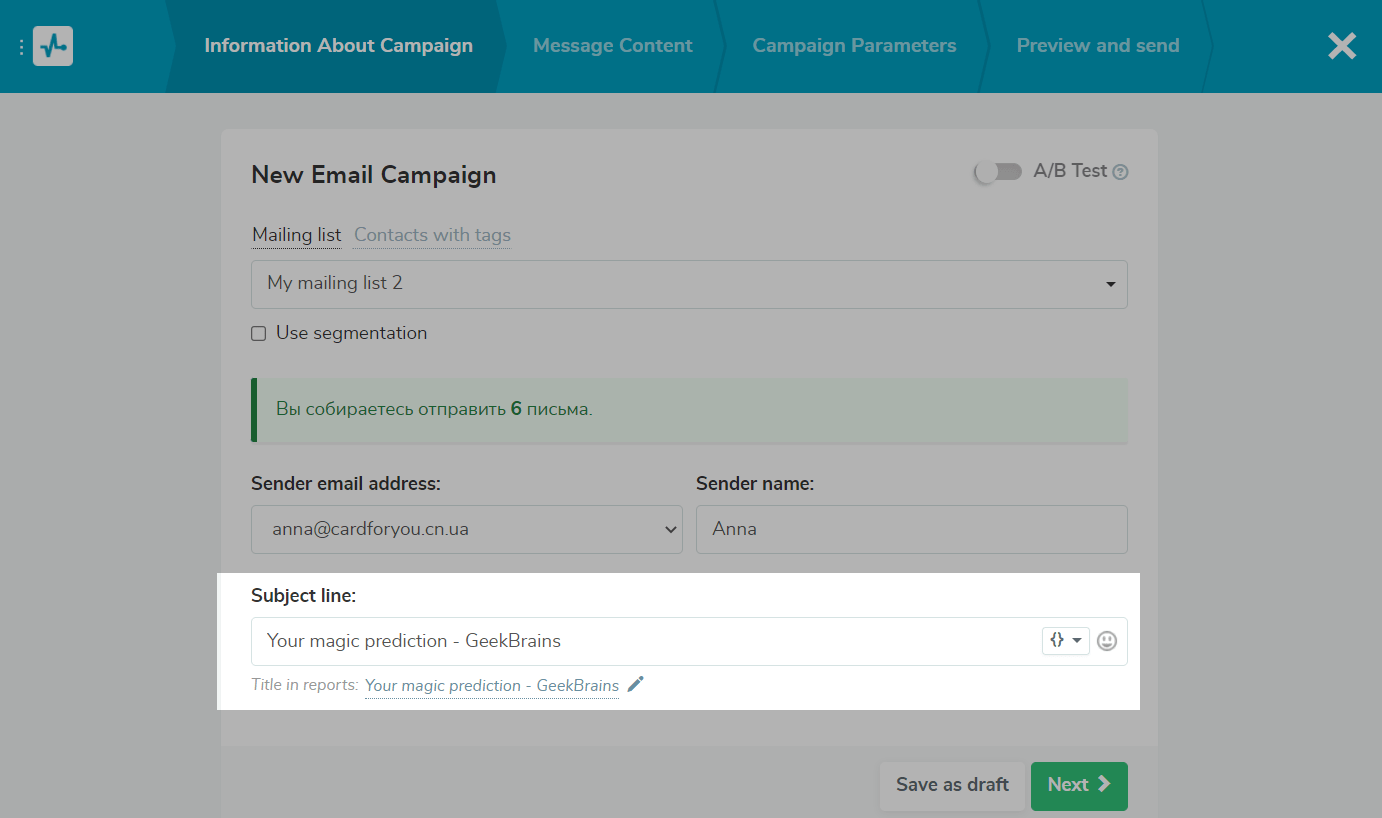
You can also set up smart personalization and send each customer a different subject line based on their data. To do this, click {}, go to the "Add Condition" tab, and configure the conditions.
Read also: What is Smart Personalization.

Step 2: Add Email Content
Choose a Template
The service provides several options for choosing your campaign template. You can:
- select the template you created earlier;
- create a new template in the drag and drop template builder;
- choose the pre-made template from those offered in the service;
- download the template from a file, via a link, or by inserting your own HTML code;
- create a new template in the HTML editor.

Select a template, and proceed to edit it.
You can personalize the message by adding the client's personal data to it.
Use simple or clever personalization in your campaigns to foster subscriber loyalty.
When you create a campaign, you can add variables from the mailing list you selected. Remember to also check all the links and variables in the template you are sending.
Read also: How to Add a Payment Button to an Email, How to Add a Calendar Event Link to an Email, and How to Create an Email Template in Dark Mode.
Add Additional Items
After saving the template, you will be taken to a page where you can add an email preheader, attach a file to the email, and include an AMP version of the email.
Read also: How to Attach a File to an Email and How to Send Large Files via Email.

Step 3: Configure Additional Campaign Options
Statistics
You can track your statistics on email opens and click-throughs. You can also allow to add tags to each link to track analytics in Google Analytics.

An unsubscribe Page and Campaign Category
You can link a custom or default unsubscribe page to an email and set the language of the unsubscribe form based on the language of your target audience.
You can set a category to give customers who are subscribed to multiple campaigns the option to unsubscribe from one of them rather than all of them at once.

Campaign Archives
Select the "Add campaign to Archive" option to access the campaign even after deleting the data from your account.
Read more: What is Email Campaign Archive.
An Autoflow Triggered by an Event
As soon as your recipients open the email or click on a link from your email, they will automatically receive subsequent emails from the flow you set up.
The option is active only if you create an autoflow with the "Webhook contact" start involving a mailing list for which an autoflow has already been created before.

Step 4: Check if the Data is Correct
Before you send the campaign to your customers, check all the data you entered.
If you need to make changes to any part of the email, click Edit, make your edits, and return to the "Preview and Send" step.
If you did not follow any of the design guidelines, the Wizard will suggest that you revise the template and the sender's address to make sure that it’s passing through spam filters successfully.
Read also: Anti-Spam Recommendations for Email Campaigns.
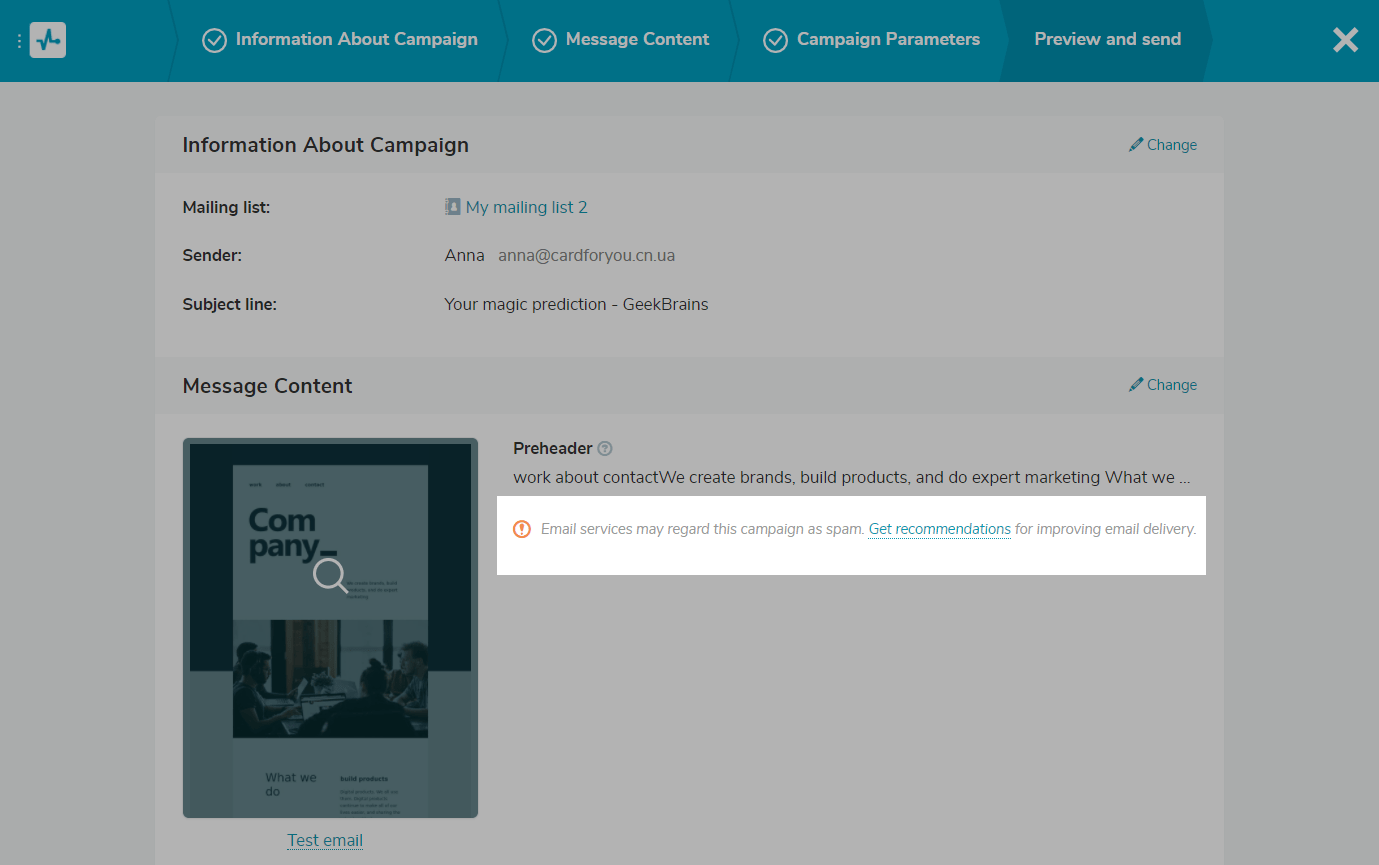
When emailing students, check if the main campaign information (course name, student progress, sender data, and subject line) is correct.

Step 5: Set Up Sending Options
Scheduling
You can send the email immediately or schedule it for a different date and time. To do this, select "Start sending" under "Time of sending," and set the desired date and time. The service will automatically send your campaign according to the schedule you have specified.
Each campaign may take up to 30 minutes to moderate before being sent.
On a paid pricing plan, the dynamic list feature is also available. The dynamic list includes contacts that have been added to the mailing list since the mailing was created before the mailing was sent.
Read also: How to Schedule Sending Emails.
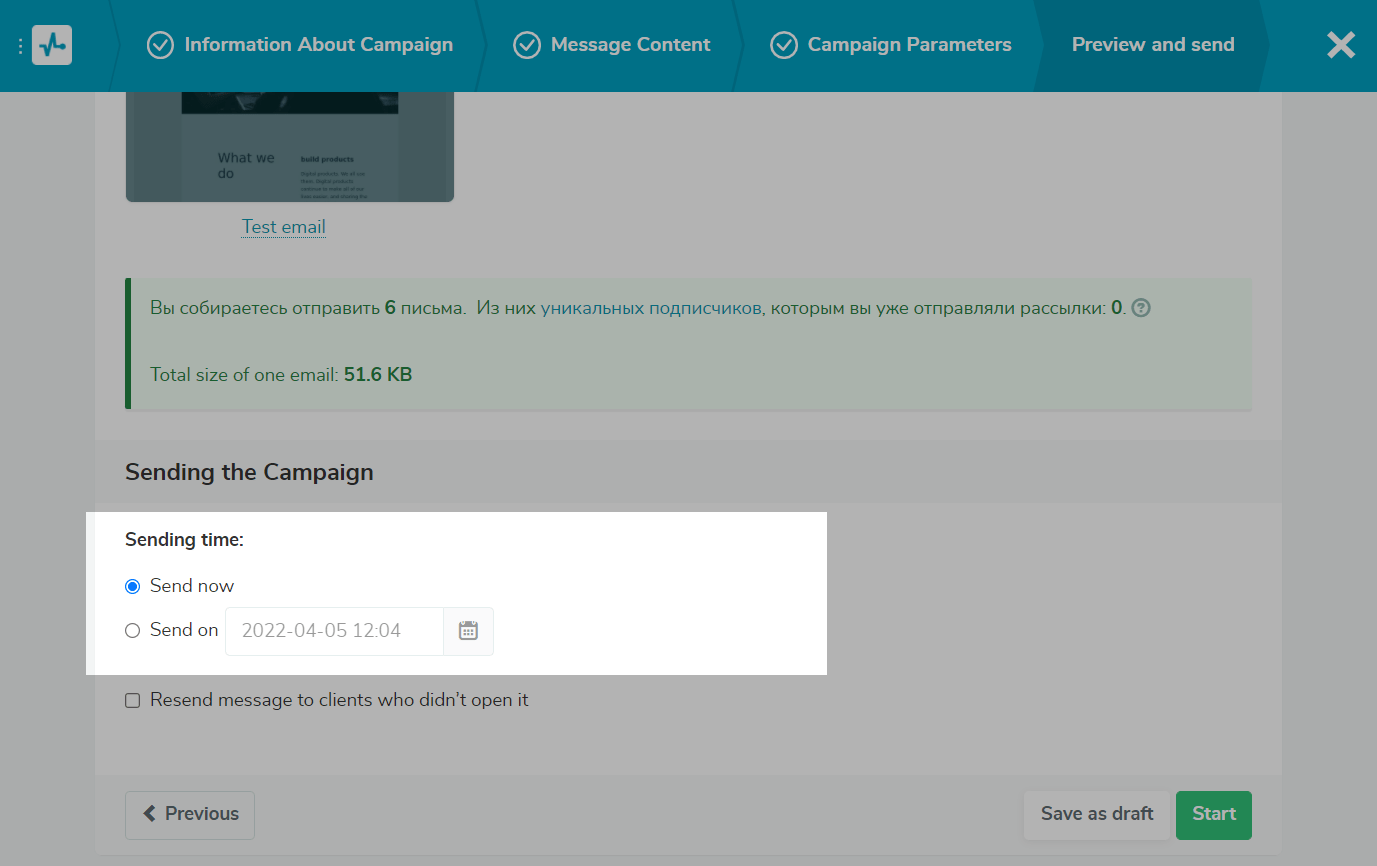
Resending an Unread Campaign
You can resend the email to subscribers who didn’t open it the first time. Select the "Send emails to unread" option, specify the new email subject of your choice, and set the sending time.
At the set time, the service will resend the email to subscribers who did not open the campaign.
Read also: How to Re-Send an Unread Campaign.

Sending in Parts
To reduce spam, email service providers restrict bulk email campaigns from new email addresses and from email addresses that have not been used for a long time or have a poor reputation.
You can improve and maintain a good IP reputation by growing the number of recipients gradually and making sure that they react positively to your emails, open them, and do not mark them as spam. In contrast, quickly sending large volumes of emails from a new domain will damage your reputation
The process of building a good reputation with providers is also called "domain warm-up." Building such a reputation for a new domain is easier than repairing a downgraded one, so make sure to send the first campaigns in small batches.
You can warm up a domain by sending out a ready-made email campaign in parts at regular intervals.
You can set the interval (once every hour, 2 hours, 4 hours, or 24 hours) and send your campaign in parts if it has more than 10,000 recipients.
Enable the "Automated warm-up" option to send your email campaign in parts that will gradually increase in volume.

You can send your email in up to 20 equal parts.

Testing the Campaign
You can send a test email before you send out the finished email to clients. Click Test Send, and select which address you want to send the email to. You can only send emails to addresses you have added as the sender address in the system.
Note that variables for personalization are not displayed in test campaigns. If you want to see how the variables will appear to your subscribers, send the campaign to a test mailing list that has your email addresses and variables filled in.

When you're ready, click Start to send the campaign.

Replacing Links in Scheduled or Sent Campaigns
If you need to replace some links in a scheduled or sent campaign, you can edit them.
To do this, go to “Campaign Overview,” and click Link viewing and editing next to “External links in your campaign.”

In the pop-up window, you will see all the links you have added to your campaign and the number of click-throughs for each link.
To replace a link, click Edit next to it, and edit the field content. Once you finish editing, click Apply to save the changes.

Last Updated: 29.05.2023
or